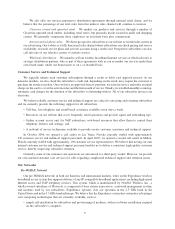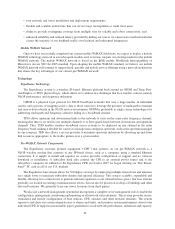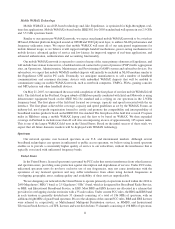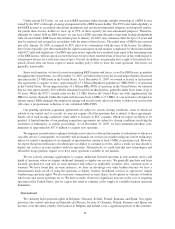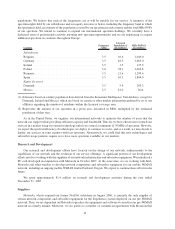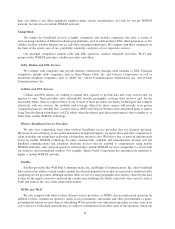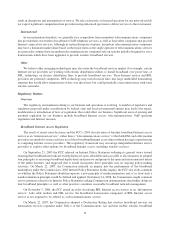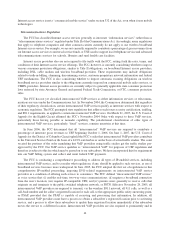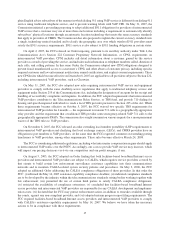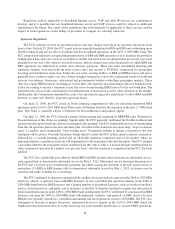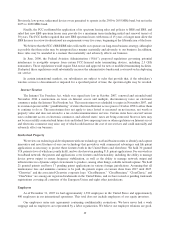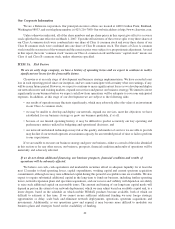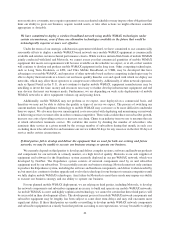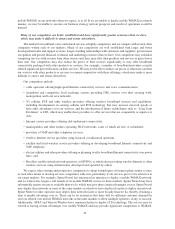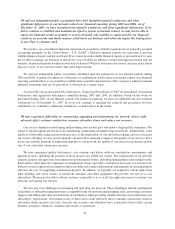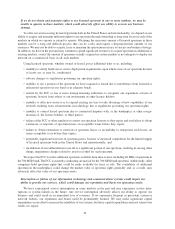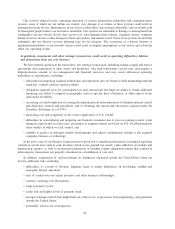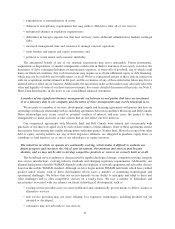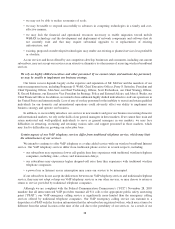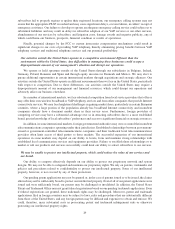Clearwire 2007 Annual Report Download - page 27
Download and view the complete annual report
Please find page 27 of the 2007 Clearwire annual report below. You can navigate through the pages in the report by either clicking on the pages listed below, or by using the keyword search tool below to find specific information within the annual report.Previously, low-power, unlicensed devices were permitted to operate in the 2500 to 2655 MHz band, but not in the
2655 to 2690 MHz band.
Finally, the FCC reaffirmed the application of its spectrum leasing rules and policies to BRS and EBS, and
ruled that new EBS spectrum leases may provide for a maximum term (including initial and renewal terms) of
30 years. The FCC further required that new EBS spectrum leases with terms of 15 years or longer must allow the
EBS licensee to review its educational use requirements every five years, beginning at the fifteenth year of the lease.
We believe that the FCC’s BRS/EBS rules will enable us to pursue our long-term business strategy, although it
is possible that these rules may be interpreted in a manner materially and adversely to our business. In addition,
these rules may be amended in a manner that materially and adversely affects our business.
In June, 2006, the Federal Aviation Administration (“FAA”), proposed regulations governing potential
interference to navigable airspace from certain FCC-licensed radio transmitting devices, including 2.5 GHz
transmitters. These regulations would require FAA notice and approval for new or modified transmitting facilities.
If adopted, these regulations could substantially increase the administrative burden and costs involved in deploying
our service.
In certain international markets, our subsidiaries are subject to rules that provide that, if the subsidiary’s
wireless service is discontinued or impaired for a specified period of time, the spectrum rights may be revoked.
Internet Taxation
The Internet Tax Freedom Act, which was signed into law in October 2007, renewed and extended until
November 2014 a moratorium on taxes on Internet access and multiple, discriminatory taxes on electronic
commerce under the Internet Tax Freedom Act. This moratorium was scheduled to expire in November 2007, and
its extension preserved the “grandfathering” of states that taxed Internet access prior to October 1998 to allow them
to continue to do so. The moratorium does not apply to taxes levied or measured on net income, net worth or
property value and does not extend to a tax on telecommunications services. Certain states have enacted various
taxes on Internet access or electronic commerce, and selected states’ taxes are being contested. State tax laws may
not be successfully contested and future state and federal laws imposing taxes or other regulations on Internet access
and electronic commerce may arise, any of which could increase the cost of our services and could materially and
adversely affect our business.
Intellectual Property
We review our technological developments with our technology staff and business units to identify and capture
innovative and novel features of our core technology that provide us with commercial advantages and file patent
applications as necessary to protect these features both in the United States and elsewhere. We hold 30 granted
U.S. patents (two of which are jointly held), and we also have ten pending U.S. patent applications. For our wireless
broadband network, the patents and applications cover features and functionality, including the ability to manage
device power output to ensure frequency stabilization, as well as the ability to manage network output and
infrastructure in a dynamic output environment to produce, among other things, reliable network uptime. We hold
21 granted patents and have 17 pending patent applications in various foreign jurisdictions. Assuming that all
maintenance fees and annuities continue to be paid, the patents expire on various dates from 2017 until 2027.
“Clearwire” and the associated Clearwire corporate logo, “ClearBusiness,” “ClearPremium,” “ClearClassic” and
“ClearValue” are among our registered trademarks in the United States, and we have issued or pending trademark
registrations covering all countries of the European Union and eight other jurisdictions.
Employees
As of December 31, 2007 we had approximately 1,590 employees in the United States and approximately
400 employees in our international operations. This total does not include employees of our equity investees.
Our employees enter into agreements containing confidentiality restrictions. We have never had a work
stoppage and no employees are represented by a labor organization. We believe our employee relations are good.
19


